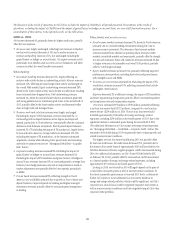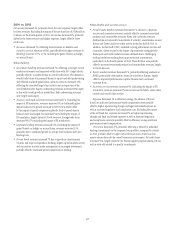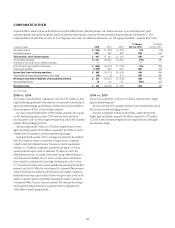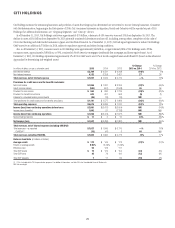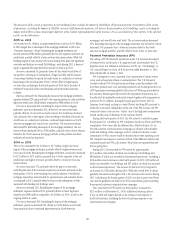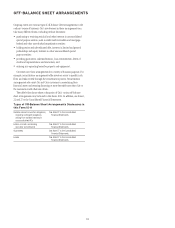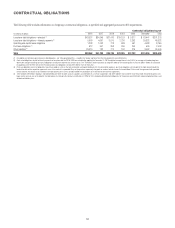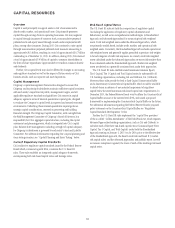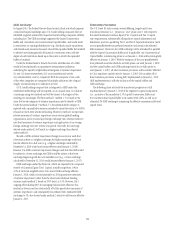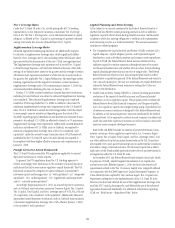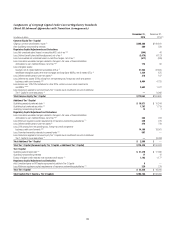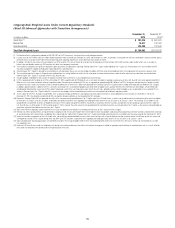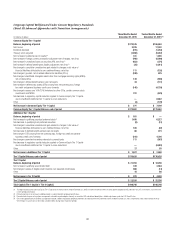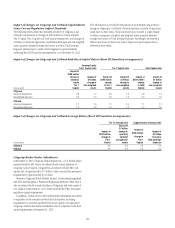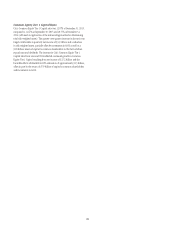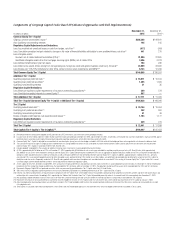Citibank 2015 Annual Report Download - page 54
Download and view the complete annual report
Please find page 54 of the 2015 Citibank annual report below. You can navigate through the pages in the report by either clicking on the pages listed below, or by using the keyword search tool below to find specific information within the annual report.36
Tier 1 Leverage Ratio
Under the U.S. Basel III rules, Citi, as with principally all U.S. banking
organizations, is also required to maintain a minimum Tier 1 Leverage
ratio of 4%. The Tier 1 Leverage ratio, a non-risk-based measure of capital
adequacy, is defined as Tier 1 Capital as a percentage of quarterly adjusted
average total assets less amounts deducted from Tier 1 Capital.
Supplementary Leverage Ratio
Advanced Approaches banking organizations are additionally required
to calculate a Supplementary Leverage ratio, which significantly differs
from the Tier 1 Leverage ratio by also including certain off-balance sheet
exposures within the denominator of the ratio (Total Leverage Exposure).
The Supplementary Leverage ratio represents end of period Tier 1 Capital
to Total Leverage Exposure, with the latter defined as the sum of the daily
average of on-balance sheet assets for the quarter and the average of certain
off-balance sheet exposures calculated as of the last day of each month in
the quarter, less applicable Tier 1 Capital deductions. Advanced Approaches
banking organizations will be required to maintain a stated minimum
Supplementary Leverage ratio of 3% commencing on January 1, 2018, but
commenced publicly disclosing this ratio on January 1, 2015.
Further, U.S. GSIBs, and their subsidiary insured depository institutions,
including Citi and Citibank, are subject to enhanced Supplementary Leverage
ratio standards. The enhanced Supplementary Leverage ratio standards
establish a 2% leverage buffer for U.S. GSIBs in addition to the stated 3%
minimum Supplementary Leverage ratio requirement in the U.S. Basel III
rules. If a U.S. GSIB fails to exceed the 2% leverage buffer, it will be subject
to increasingly onerous restrictions (depending upon the extent of the
shortfall) regarding capital distributions and discretionary executive bonus
payments. Accordingly, U.S. GSIBs are effectively subject to a 5% minimum
Supplementary Leverage ratio requirement. Additionally, insured depository
institution subsidiaries of U.S. GSIBs, such as Citibank, are required to
maintain a Supplementary Leverage ratio of 6% to be considered “well
capitalized” under the revised Prompt Corrective Action (PCA) framework
established by the U.S. Basel III rules. Citi and Citibank are required to
be compliant with these higher effective minimum ratio requirements on
January 1, 2018.
Prompt Corrective Action Framework
The U.S. Basel III rules revised the PCA regulations applicable to insured
depository institutions in certain respects.
In general, the PCA regulations direct the U.S. banking agencies to
enforce increasingly strict limitations on the activities of insured depository
institutions that fail to meet certain regulatory capital thresholds. The PCA
framework contains five categories of capital adequacy as measured by
risk-based capital and leverage ratios: (i) “well capitalized”; (ii) “adequately
capitalized”; (iii) “undercapitalized”; (iv) “significantly undercapitalized”;
and (v) “critically undercapitalized.”
Accordingly, beginning January 1, 2015, an insured depository institution,
such as Citibank, must maintain minimum Common Equity Tier 1 Capital,
Tier 1 Capital, Total Capital, and Tier 1 Leverage ratios of 6.5%, 8%, 10% and
5%, respectively, to be considered “well capitalized.” Additionally, Advanced
Approaches insured depository institutions, such as Citibank, must maintain
a minimum Supplementary Leverage ratio of 6%, effective January 1, 2018,
to be considered “well capitalized.”
Capital Planning and Stress Testing
Citi is subject to an annual assessment by the Federal Reserve Board as to
whether Citi has effective capital planning processes as well as sufficient
regulatory capital to absorb losses during stressful economic and financial
conditions, while also meeting obligations to creditors and counterparties
and continuing to serve as a credit intermediary. This annual assessment
includes two related programs:
• The Comprehensive Capital Analysis and Review (CCAR) evaluates Citi’s
capital adequacy, capital adequacy process, and its planned capital
distributions, such as dividend payments and common stock repurchases.
As part of CCAR, the Federal Reserve Board assesses whether Citi has
sufficient capital to continue operations throughout times of economic
and financial market stress and whether Citi has robust, forward-looking
capital planning processes that account for its unique risks. The Federal
Reserve Board may object to Citi’s annual capital plan based on either
quantitative or qualitative grounds. If the Federal Reserve Board objects to
Citi’s annual capital plan, Citi may not undertake any capital distribution
unless the Federal Reserve Board indicates in writing that it does not
object to the distribution.
• Dodd-Frank Act Stress Testing (DFAST) is a forward-looking quantitative
evaluation of the impact of stressful economic and financial market
conditions on Citi’s regulatory capital. This program serves to inform the
Federal Reserve Board, the financial companies, and the general public,
how Citi’s regulatory capital ratios might change using a hypothetical set
of adverse economic conditions as designed by the Federal Reserve Board.
In addition to the annual supervisory stress test conducted by the Federal
Reserve Board, Citi is required to conduct annual company-run stress tests
under the same three supervisory scenarios as well as conduct a mid-cycle
stress test under company-developed scenarios.
Both CCAR and DFAST include an estimate of projected revenues, losses,
reserves, certain pro forma regulatory capital ratios (i.e., Common Equity
Tier 1 Capital, Tier 1 Capital, Total Capital, and Tier 1 Leverage ratios), and
any other additional capital measures deemed relevant by Citi. Projections
are required over a nine-quarter planning horizon under baseline conditions
and under a range of stressed scenarios. All risk-based capital ratios reflect
application of the Standardized Approach framework only and the transition
arrangements under the U.S. Basel III rules.
In November 2015, the Federal Reserve Board released a final rule, which
for purposes of CCAR, adopted targeted amendments to its capital plan
and stress test rules. Effective January 1, 2016, the final rule removed all
requirements related to the Tier 1 Common Capital ratio (originally defined
in conjunction with the 2009 Supervisory Capital Assessment Program), as
it has effectively been replaced by the Common Equity Tier 1 Capital ratio
requirement subsequent to the implementation of the U.S. Basel III rules.
Moreover, the final rule delayed the use of the Supplementary Leverage ratio
until the 2017 capital planning cycle, and deferred the use of the Advanced
Approaches framework indefinitely. For additional information regarding
CCAR, see “Risk Factors—Regulatory Risks” below.


